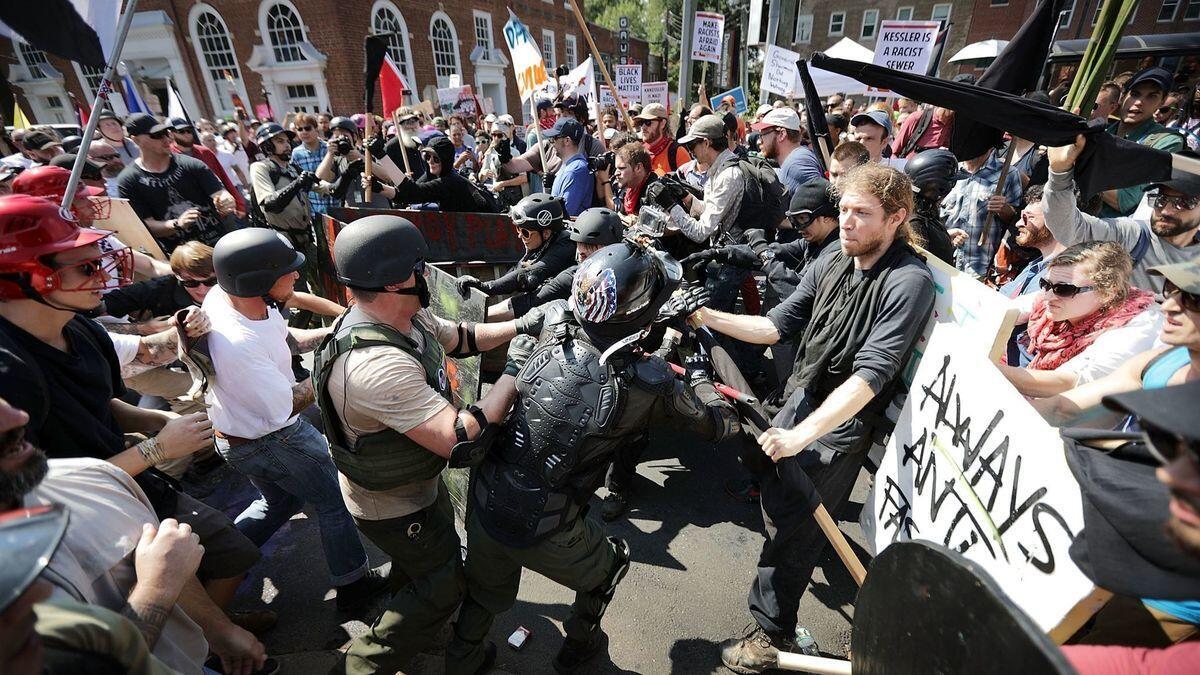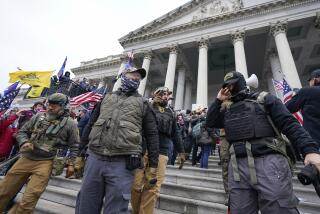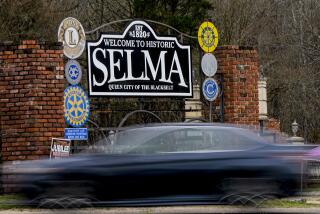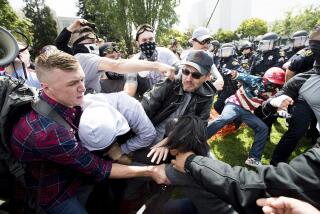A year after Charlottesville, many white supremacists are keeping a lower profile

A year ago, white supremacists were ready for a big show of unity in Charlottesville.
Hundreds traveled to the city for a rally in support of their belief that white people are superior. But the gathering quickly became violent, and an anti-racism protester was killed when a car rammed into a crowd.
Since then, many supporters of “white rights” who frequently appeared on campus speaking tours or smaller gatherings throughout the country have become significantly less visible even as the number of neo-Nazi groups has increased, according to members of white supremacy groups, anti-racism activists and other observers.
The spectacle of Charlottesville, Va., has kept the far right movement more splintered than united, even as demonstrations such as one in Portland, Ore., on Saturday still draw right-wing extremists and counter-protesters, raising concerns about violence.
Several leaders of white supremacist groups have said during the last year, often via social media, that their followers should avoid such public events.
Michael Hill, who leads the Alabama-based pro-Confederate group League of the South, told his followers in a May podcast that they do not have “anything to gain” from another Charlottesville, a common sentiment on fringe message boards and chat networks.
Brad Griffin, a prominent blogger who has pushed for a “Jew-free, white ethnostate in North America” on his website Occidental Dissent, recently wrote that racists should be careful about showing up at public gatherings.
“I don’t believe we should engage with them at all anymore,” Griffin wrote last month of counter-demonstrators.
Before and since Charlottesville, civil rights groups warned that the country could be facing a new era, with racists becoming more emboldened to display their views in violent public demonstrations. That movement, many now say, has slowed down.
“One of the most important effects of the post-Charlottesville year has been the inability for these right-wing extremist groups to unite the way they had hoped to,” said Oren Segal, director of the Anti-Defamation League’s Center on Extremism. “The backlash that came from that event has led to infighting and division, which has led to pressure on these groups in ways we have not seen.”
The weekend in Charlottesville last year ended with the death of 32-year-old counter-protester Heather Heyer, a helicopter crash that killed two state troopers, and scores of injuries. President Trump’s reaction, where he assigned blame to “both sides,” further fueled tensions as vigils took place across the country.
In some cases, white supremacists were ostracized in their communities. Some were banned from online fundraising portals or fired from their jobs. Others chose not to expose themselves to the criticism that comes with public events.
An attempt to bring scores of white supremacists back to Charlottesville this month to mark the anniversary of last year’s rallies fizzled. The city declined to host an official commemoration, though churches plan healing services and university students announced a protest against racism.
Instead of Charlottesville, organizer Jason Kessler plans to hold a “white civil rights” anniversary rally Aug. 12 in Washington across from the White House. The event will not be “about hating anybody,” but rather about supporting a race that “is becoming a minority in the United States,” he said.
Nevertheless, even some of those who agree with him have disassociated themselves.
“I have nothing to do with it, and I have nothing to do with Jason Kessler,” Richard Spencer, a white nationalist who marched with tiki torches on the University of Virginia campus last year, wrote in an email.
Spencer, who helped promote last year’s rally, shunned Kessler after he celebrated the violence. Spencer encouraged other racist groups to no longer follow him.
Facing growing protests and thinning crowds as he traveled the country, Spencer recently disbanded his college tour. Last month, white nationalist Christopher Cantwell was banned from entering the state of Virginia for five years after pleading guilty to assault for using pepper spray on a crowd last year on the University of Virginia campus.
In the last year, other extremist groups that were present in Charlottesville, including the Traditionalist Workers Party and Vanguard America, have splintered. James Fields, the Ohio man charged in Heyer’s death, had posed with Vanguard America at the 2017 rally while holding a shield with neo-Nazi symbols.
Nevertheless, police in Washington, Charlottesville and other cities said they are on the lookout for clashes among groups known for seeking confrontation.
While civil rights groups predicted violence last year and mobilized counter-protesters, ministers and legal observers to attend, many say the best way to respond remains unclear.
“Some people say to not pay them attention or give oxygen. Others believe that we have to openly resist,” said Carolyn Gallaher, a professor at American University who studies right-wing militias.
The Rev. Traci Blackmon, a Florissant, Mo.-based pastor who helped organize clergy from across the country to counter-protest last year in Charlottesville, said she’s not sure whether she’ll attend the Washington event.
“I am trying to decide whether I want to give white nationalists the attention they received in Charlottesville and that they continue to clamor after,” said Blackmon, who is executive minister of justice and witness ministries for the United Church of Christ.
In Washington, dozens of local organizations as well as Black Lives Matter and civil rights groups from New York, Philadelphia and Charlottesville also plan to rally on Aug. 12 on a plaza east of the White House. The schedule calls for “marching bands, drummers, puppets and vibrant displays of art and culture.”
After the violence last year, dozens of cities including Baltimore and Lexington, Ky., rushed to take down Confederate statues similar to the ones right-wing groups said they were protecting in Virginia.
In Durham, N.C., protesters took it upon themselves to tie rope around a 93-year-old bronze statue of a Confederate soldier and pulled it down. In Charlottesville, the city placed tarps over park statues of Robert E. Lee and Stonewall Jackson while it grappled with a Virginia law that protects war monuments from removal.
“That movement has also slowed down,” said Heidi Beirich, director of the Southern Poverty Law Center’s Intelligence Project.
A state judge this year ordered Charlottesville to take down the tarps. The City Council gave the parks that hold the statues new names. Once Lee and Jackson parks, they were renamed last year to Emancipation and Justice. Last month, the City Council renamed them again to avoid further controversy: Market Street and Court Square.
“I sense a lack of urgency” compared with activism immediately after last summer’s events, said Charlottesville resident the Rev. Seth Wispelwey, who said his community continues to mourn. The church where he is a minister, Congregate C’ville, is among those holding healing services on the anniversary.
According to a report the Southern Poverty Law Center released in June, more than 1,700 Confederate memorials stand in the U.S. At least 55 were removed last year, many of them statues and physical monuments. This year, the center has counted only a handful of monument removals, though more than a dozen schools and roads have been renamed.
Beirich said disunity among white extremists doesn’t mean their threat has declined.
The group’s annual count of hate groups, released in February, showed an increase, to 954 from the 917 it documented the previous year. In addition to white supremacists, they include anti-LGBTQ, anti-Muslim and black nationalist groups. The report also showed a 22% increase in neo-Nazi groups last year, to 121.
Beirich said that whether or not groups rely on demonstrations, it’s important to note sentiment over race, immigration, and religion — areas where polls and electoral races are showing increasing divisions.
“The biggest issue ultimately after Charlottesville is that whatever happens to these alt-right groups, these anti-immigrant ideas, anti-Muslim ideas, they have totally penetrated the mainstream,” she said.
Twitter: @jaweedkaleem
Times staff writer James Queally contributed to this report.
More to Read
Sign up for Essential California
The most important California stories and recommendations in your inbox every morning.
You may occasionally receive promotional content from the Los Angeles Times.











